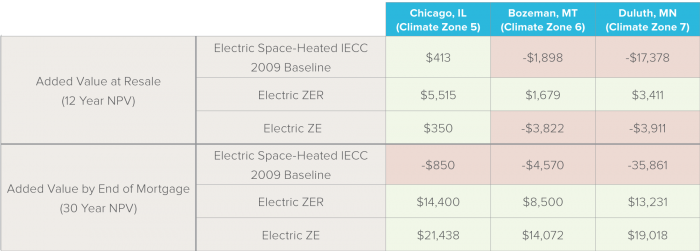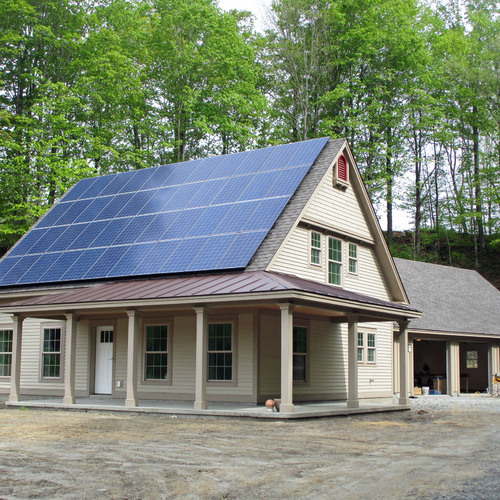
A decade ago, the prevailing wisdom held that all-electric buildings presented many challenges: They were served by dirty coal instead of cleaner natural gas, they struggled to meet temperature setpoints in cold climates, and they drastically increased utility bills.
Why, then, this big push toward electrification? Simply put, electrification is an essential strategy for achieving the aggressive climate goals laid out in America’s Pledge and in the climate action plans implemented by leading cities across the country. And electrification is now being fueled more and more by clean renewable energy, which is cheaper (in most cases) than natural gas — and is by far safer and healthier.
However, the myth of all-electric buildings not meeting demand in cold climates continues. Rocky Mountain Institute’s (RMI’s) new Cold Climate Addendum to our Economics of Zero-Energy Homes: Single Family Insights report is the latest in a series of myth-busting reports showing how many of these assumptions are outdated. Our analysis demonstrates how deep efficiency combined with photovoltaic (PV) panels can drastically improve the economics of electrification and make our homes safer and more comfortable.
Why electrify?
Reducing greenhouse gas (GHG) emissions by 80% or more will require essentially eliminating the GHGs produced by buildings — which is only possible at scale with all-electric buildings tied to a clean electricity grid. Electrification is also essential to improve the safety of our housing stock.
Seventy million American homes and businesses burn natural gas, oil, or propane on site to heat their space and water and cook food, generating 560 million tons of carbon dioxide equivalent (CO2e) emissions each year — a tenth of total U.S. CO2 emissions. Having natural gas in homes can also create health and safety concerns. For example, leaks can result in carbon monoxide poisoning, which causes 400 deaths, 20,000 visits to an emergency room, and 4,000 hospitalizations in America annually, according to the Centers for Disease Control and Prevention.
In short, buildings are responsible for upwards of a billion tons of annual CO2e emissions — all because we burn a highly explosive gas in our furnaces, hot water heaters, clothes dryers, stoves, and fireplaces.
The United States is making significant progress in replacing coal with clean energy, with overall coal use declining from over 50% of electricity generation to under 30% in less than a decade. While Figure 1 (below) shows that the grid has gotten cleaner in the last decade by reducing coal and increasing renewable sources of electricity like wind and solar, there is still a long way to go before our grid becomes carbon-free.
RMI’s Economics of Electrifying Buildings report clearly shows that electrifying the building stock today will result in carbon reductions in the majority of the United States and, in the pockets of the country where coal power is still a significant portion of the electricity mix, we expect those coal plants will be shut down in the foreseeable future.
[Image source: U.S. Energy Information Administration]
Is electrification possible in cold climates?
Just as the grid has improved over the past decade, so has building technology. Cold climate heat pumps can effectively heat houses even as outdoor temperatures hit -12°F, with supplemental electric-resistance heat as a backup when really needed. In our analysis, supplemental heat was utilized only 3% of the time in Bozeman, Montana (representing Climate Zone 6), and 10% of the time in Duluth, Minnesota (representing Climate Zone 7).
Heat-pump water heaters (HPWHs) also utilize electric-resistance backup heat for those times when heat-pump technology alone cannot meet water temperature setpoints, whether due to an undersized system or the ambient temperature getting too low. In cold climates, HPWHs should be placed indoors so they are not utilizing electric-resistance heat excessively.
Placing HPWHs indoors eliminates the requirement for electric-resistance backup heat, but does increase the amount of space heating needed. The good news is that in both cold climate locations studied, the heat pumps were able to maintain space and water heating at desired temperatures.
How economical are all-electric zero-energy homes?
Despite electrification being technically feasible, only 8% of all existing homes are served by electric space heating in cold climates, and less than 1% are served by heat pumps. This is likely due to electrification resulting in higher utility bills when it is not implemented as part of a highly-efficient, integrated design strategy.
We modeled an all-electric baseline and a natural gas baseline in Climate Zones 5, 6, and 7, with both baselines meeting IECC 2009 energy code standards. We found that while the up-front costs tend to be lower for an all-electric baseline, the energy bills were significantly higher in colder climates.
Interestingly enough, you can tunnel through this economic barrier by pursuing deeper levels of efficiency and adding PV. In Table 1, we compare an electric code-baseline home, an electric zero-energy (ZE) home, and an electric zero-energy ready (ZER) home to a natural gas baseline home using the net present value of up-front cost and energy bill savings over 12 years (the typical time homeowners plan to stay in their homes) and 30 years (the typical mortgage length). We define a ZE home as a home that produces as much renewable energy as it uses over the course of a year and a ZER home as a home that is as efficient as a ZE home, but without renewables.

We found that, in every instance, pursuing ZER homes was more economical than just electrifying space-heating equipment with code-compliant equipment, and in colder climates it actually changed the economics of electrification from being painful to homeowners to being beneficial.
ZE homes told a more interesting economic story. Over the resale timeframe, they performed economically in a fairly similar way to simply electrifying the heating equipment with code baseline equipment, except in Climate Zone 7, where ZE homes were far more economical. Using the 30-year mortgage timeframe, ZE homes are more economical than both ZER and electric baseline homes. It is worth noting that while this analysis includes the federal solar investment tax credit, it does not include local incentives nor savings from eliminating gas hookups, which would help ZE homes break even with natural gas homes even sooner.
Looking toward the future
Electrification is a requisite strategy for achieving our climate action and public health goals. While deep levels of efficiency can make electrification in newly constructed homes economic today, builders may need a push from policymakers and utilities to feel comfortable changing their designs from business-as-usual natural gas in these cold-climate locations.
Policymakers and utilities should stop incentivizing new gas hookups and appliances. Additionally, utilities should stop socializing the cost of gas infrastructure extensions through their rate bases. Instead, they should begin providing incentives to homeowners and builders to electrify, including offering expedited permitting for electric equipment, more financial incentives, and technical assistance and training for the labor force.
The good news is many cities understand the importance of electrification and are developing policies to promote it, which will result in a decarbonized and safer building stock.
Alisa Petersen and Michael Gartman are senior associates on the Rocky Mountain Institute’s Buildings team. ©2019 Rocky Mountain Institute. Published with permission. Originally posted at the RMI Outlet.
Weekly Newsletter
Get building science and energy efficiency advice, plus special offers, in your inbox.















16 Comments
I agree with the conclusions of the authors, but unlike the authors, I don't think that the Rocky Mountain Institute deserves credit for "myth busting." GBA has promoting all-electric homes heated and cooled by ductless minisplits for at least seven years.
Perhaps when the article refers to this report as "the latest in a series of myth-busting reports showing how many of these assumptions are outdated," they are including your 2012 article as one of the first in the series.
RMI has done a number of articles in the past 8 -10 years on the economics of heat pumps vs. other space heating options, even in cold climates. It was about six years ago they published a juicy bit titled "Heat Pumps: An alternative to oil heat for the Northeast", and it wasn't their first.
https://www.rmi.org/wp-content/uploads/2017/05/RMI_Document_Repository_Public-Reprts_2013-05_HeatPumps.pdf
NYSERDA has been on that bandwagon too since at least 2014:
https://www.nyserda.ny.gov/-/media/Files/EDPPP/Energy-Prices/Current-Outlook/Presentations/Heat-Pumps-Potential.pdf
(Note, they reference the May 2013 RMI article in that piece in the long list of credits at the end, near the bottom of p33/p40 in PDF pagination)
The RMI and NYSERDA analysis are refering to retrofitting heat pumps into code or sub-code existing houses, which distinguishes it from Carter Scott's Net Zero houses heated with a couple of mini-splits. It's an important distinction to make, lest people get the impression that heat pumps are only for high-R houses.
It takes more than a couple of mini-splits to heat a 50-100 year old 2x4 framed house in a cold climate but it can still be more economic than propane or #2 oil, even without pricing carbon emissions, even in high-electricity price markets.
Nate Adams has done pretty well at getting the word out on the benefits of electrification of mechanical systems for the past half decade or more too, expanding beyond mere building envelope upgrades:
http://www.natethehousewhisperer.com/blog/electrify-everything-7-practical-steps-to-using-100-renewable-energy
https://www.greenbuildingadvisor.com/article/how-an-efficiency-program-killed-my-business
https://www.greenbuildingadvisor.com/article/designing-a-one-knob-incentive-program
https://www.greenbuildingadvisor.com/article/hard-truths-of-home-performance
I don't understand the supplied chart. It doesn't seem to support their conclusion that one can "tunnel through" the higher up-front costs.
Jay,
I agree that the chart is confusing. It displays "added value at resale," so positive numbers are good, and negative numbers are bad. After 12 years, investing in the zero-energy features in Bozeman or Duluth prove to be a bad investment (strictly on the basis of those 12 years), whereas investing in zero-energy-ready features in those same cities would prove to be a good investment (relatively speaking) over the same 12 years.
If you consider 30 years, the zero-energy features as well as the zero-energy-ready features all prove to be relatively good investments, in all studied locations.
>"I don't understand the supplied chart. It doesn't seem to support their conclusion that one can "tunnel through" the higher up-front costs."
Sure it does.
For all three locations on an present value basis the electrically heated Zero Energy Ready house is more valuable than the baseline electric heated version at both 12 years (anticipated duration of tenancy) and 30 years (mortgage & heating equipment lifecycle). If you expect to be there at least 12 years the cost of the envelope upgrades alone will be "worth it" despite the upcharge, but maybe not the solar.
At 30 years the electrically heated full Zero Energy house is even more strongly NPV+ in all three locations than the merely ZER, so on a lifecycle basis the full ZE approach will outpace the value of the alternatives. If it's your "forever home" and you anticipate 30 years of additional lifespan it's still a good investment, but maybe not if you're 85 years old with health problems.
It's difficult to model the falling cost of solar and changing regulatory landscape, but building to ZER levels tunnels through the cost barrier pretty cleanly, and if PV get cheaper sooner than expected the option to install it doesn't go away.
I didn't really believe that electric heat made much sense - but now Runtal electric panels are the plan for my house rehab as backup to wood-stove heat. Go figure.
Greg- Unless you have really cheap electricity heating with the electric Runtal panels is going to be very expensive, using the same amount of electricity as cheaper baseboard. The "all-electric baseline" use in the analysis involves heat pumps, not electric panel radiators.
https://rmi.org/insight/the-economics-of-electrifying-buildings/
Air source heat pumps will use anywhere from about 1/4 to 1/2 the amount of electricity as the electric panels to deliver the same amount of heat (depending on climate and heat pump model.) So multiply the all-electric baseline numbers by about 3x (give or take) if heating with electric panels.
Dana,
This is something I'm still trying to work my way through. In a house that uses wood as it's primary heat source, electric baseboard provides not only a back-up, but a way to evenly distribute the heat, zone the house, or provide heat only to certain areas when the occupants are away. A mini-split is perhaps a better source of back-up heat if the stove isn't in use, but isn't as flexible for the other functions.
To be sure it's dead-easy to completely micro-zone a house with electric baseboard, and impossible to micro zone a house with ductless while retaining most of the efficiency advantages.
Mini-splits make a good backup for wood heat even when the wood IS being used. As the embers die down the mini-split can pick up the difference- they "play nice" together when both are reasonably sized for the loads.
I was responding to Greg's:
"I didn't really believe that electric heat made much sense - but now Runtal electric panels are the plan..."
If they are actually used on a regular basis the Runtal panel plan is a pretty bad plan. Unless electricity is unusually cheap, electric heat in the form of panel rads still doesn't make much sense. In average or high priced electricity markets electric panel-rads reduce the re-sale value since most home buyers aren't interested in managing bulk fuel like wood for space heating, nor are they keen to be paying ~3x as much to heat the house with electric radiators or baseboards compared to a heat pump.
Ducted mini-splits have come a long way in the past decade on both efficiency and cold-temperature capacity , which gets around the distribution issues, though ducts are still a significant cost-adder over a wall-coil type, and come with at least some design/implementation risks that ductless doesn't have.
Midea's cold climate ducted mini-splits that use Toshiba's vapor injection compressor technology test at comparable cool temp capacity & efficiency as better class cold climate wall coil types of a decade ago (and have been picked up by Carrier)
eg: The 1.5 ton 40MBDQ18---3 + 38MAQB18R--3 tests at an HSPF of 10.5, which is a hair better than where Mitsubishi's FE18 wall coil type was a decade ago:
https://dms.hvacpartners.com/docs/1009/Public/08/40MBDQ-18-3-01SB.pdf
https://dms.hvacpartners.com/docs/1009/Public/0B/SUB38MAR-18-3-01.pdf (HSPF listed in the ducted section)
... vs ...
http://meus1.mylinkdrive.com/files/MSZ-FE18NA_MUZ-FE18NA_Submittal.pdf
38MAQB18R--3
To be fair the FE18 has 20% more capacity at -15C (21,600 BTU/hr vs. 18,000 BTU/hr), but it's modulation range isn't as good as the 1.5 ton ducted Midea. Capacity-wise the ducted Midea more comparable to the current FH15 (there never was an FE15), but substantially less efficient:
http://meus1.mylinkdrive.com/files/MSZ-FH15NA_MUZ-FH15NA_Submittal.pdf
The 1.5 ton Fujitsu 18RLFCD is still a better compromise than the Midea/Carrier as long as you don''t really need a pan heater for defrost ice management, with it's marginally higher efficiency and and larger modulation range:
http://www.fujitsugeneral.com/us/resources/pdf/support/downloads/submittal-sheets/18RLFCD.pdf
Thanks Dana,
It's also a bit of a gamble to assume that future occupants will want to continue using the wood stove as their primary heat. The house I'm building now has a wood stove and a ductless mini-split in the main open living areas, with baseboard resistance in the bathrooms and bedrooms. A bit of everything which hopefully allows a fair number of useful variations depending on owner preference and behaviour.
My brain is no longer efficient enough to comprehend these tables, but I know my 2bFujitsu hyper heat minis do a great job heating most of my average insulated house. I use an energy kinetics oil boiler too which is much more efficient than others. Eventually I would like to add a few more minis, heat pump water heat and a pv system to eliminate the boiler and get to near zero. The problem with the minis is that the mark up to install is way too high. I will wait until the self install units ( eg blueridge) become more efficient.. When that happens you will see mini split usage explode. It is just too expensive upnfront now.
Nick: At any efficiency there are both efficiency & equipment longevity risks to DIY installing a mini-split without the necessary equipment & experience. Even a tiny amount of water in the system will shorten it's lifespan, even if it works just fine when you throw the switch the first time. If you're going to DIY a mini-split take the time to learn everything you can about it, (and in the US, get the necessary certification for handling refrigerants- it's not super hard, but it's harder than reading the charts in this blog) and be very meticulous with every step.
Doing an "all but refrigerant charge & commissioning" DIY installation can take some of the cost out of it, if you can find a qualified refrigerant tech with the tools and experience to get that part right. A few hundred for the service call is usually less than what it takes to buy the equipment, and could save you from having to replace it in only a few years. Even the BlueRidge units require the pro to do the dry nitrogen line flushing & pump downs etc, as indicated in their installation video:
https://youtu.be/DzVJiSQNbew
“[Deleted]”
In short, buildings are responsible for upwards of a billion tons of annual CO2e emissions — all because we burn a highly explosive gas in our furnaces, hot water heaters, clothes dryers, stoves, and fireplaces."
Great article, but the above quote is problematic. The bit about natural gas causing carbon monoxide poisoning is misleading, is it not? Any fuel combustion in a closed space which isn't ventilated properly (including wood) can cause CO poisoning, so siting this as an example of the health risks associated with NG is wrong.
Also, it's just a bit alarmist to use the term "highly explosive gas", even if it's true. Sort of just stating the obvious, isn't it? People get electrocuted, so we should probably stop using electricity, too.
Log in or create an account to post a comment.
Sign up Log in